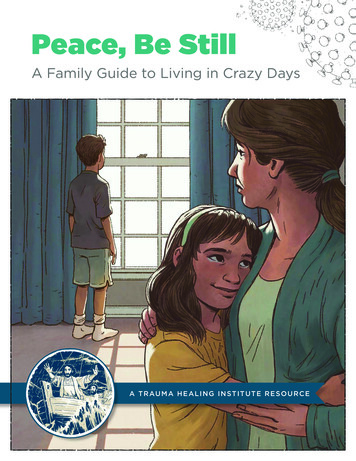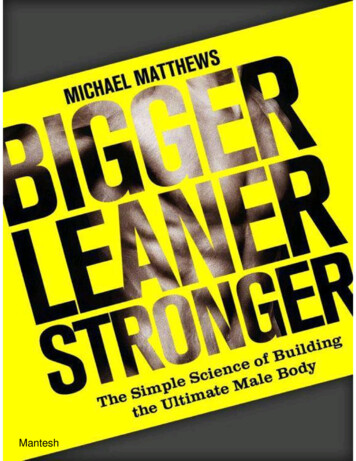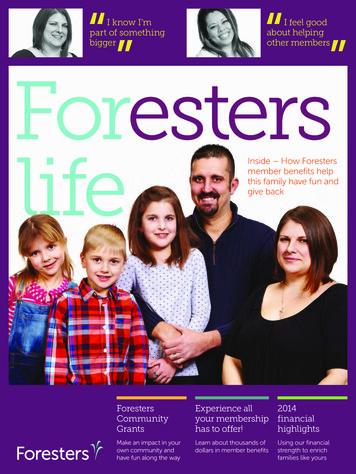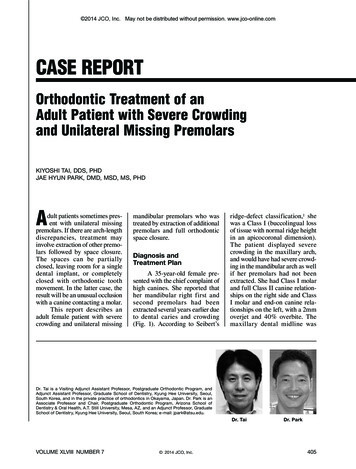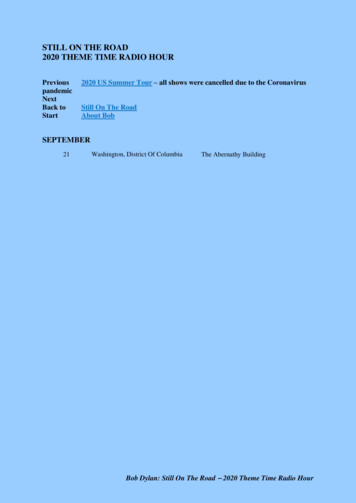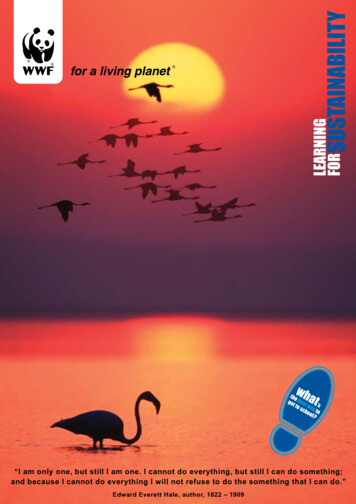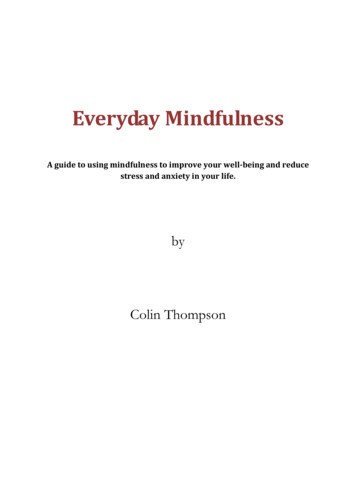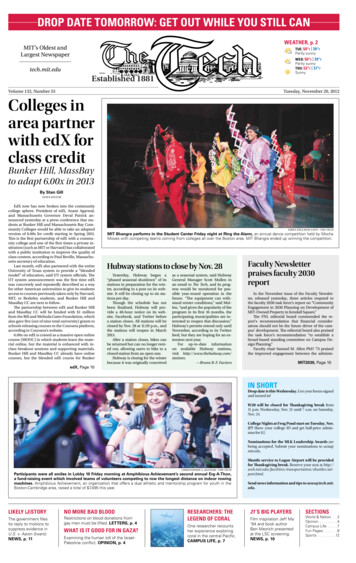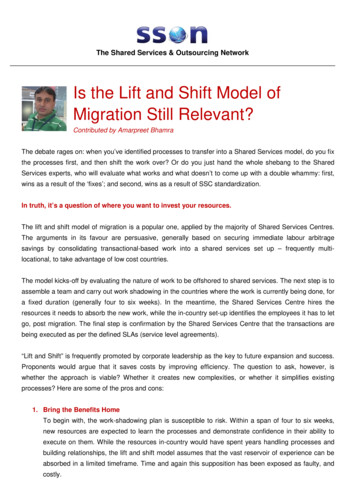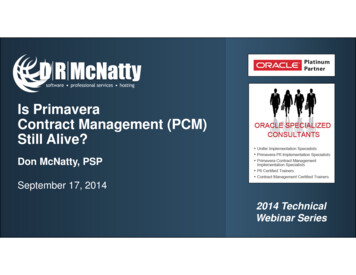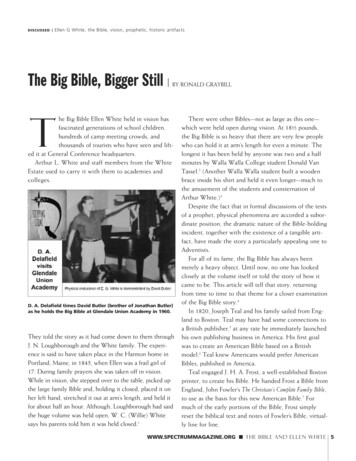
Transcription
DISCUSSED Ellen G White, the Bible, vision, prophetic, historic artifactsThe Big Bible, Bigger Still BY RONALD GRAYBILLhe Big Bible Ellen White held in vision hasfascinated generations of school children,hundreds of camp meeting crowds, andthousands of tourists who have seen and lifted it at General Conference headquarters.Arthur L. White and staff members from the WhiteEstate used to carry it with them to academies andcolleges.TD. A. Delafield times David Butler (brother of Jonathan Butler)as he holds the Big Bible at Glendale Union Academy in 1960.They told the story as it had come down to them throughJ. N. Loughborough and the White family. The experience is said to have taken place in the Harmon home inPortland, Maine, in 1845, when Ellen was a frail girl of17. During family prayers she was taken off in vision.While in vision, she stepped over to the table, picked upthe large family Bible and, holding it closed, placed it onher left hand, stretched it out at arm’s length, and held itfor about half an hour. Although, Loughborough had saidthe huge volume was held open, W. C. (Willie) Whitesays his parents told him it was held closed.1There were other Bibles—not as large as this one—which were held open during vision. At 18½ pounds,the Big Bible is so heavy that there are very few peoplewho can hold it at arm’s length for even a minute. Thelongest it has been held by anyone was two and a halfminutes by Walla Walla College student Donald VanTassel.2 (Another Walla Walla student built a woodenbrace inside his shirt and held it even longer—much tothe amusement of the students and consternation ofArthur White.)3Despite the fact that in formal discussions of the testsof a prophet, physical phenomena are accorded a subordinate position, the dramatic nature of the Bible-holdingincident, together with the existence of a tangible artifact, have made the story a particularly appealing one toAdventists.For all of its fame, the Big Bible has always beenmerely a heavy object. Until now, no one has lookedclosely at the volume itself or told the story of how itcame to be. This article will tell that story, returningfrom time to time to that theme for a closer examinationof the Big Bible story.4In 1820, Joseph Teal and his family sailed from England to Boston. Teal may have had some connections toa British publisher,5 at any rate he immediately launchedhis own publishing business in America. His first goalwas to create an American Bible based on a Britishmodel.6 Teal knew Americans would prefer AmericanBibles, published in America.Teal engaged J. H. A. Frost, a well-established Bostonprinter, to create his Bible. He handed Frost a Bible fromEngland, John Fowler’s The Christian’s Complete Family Bible,to use as the basis for this new American Bible.7 Formuch of the early portions of the Bible, Frost simplyreset the biblical text and notes of Fowler’s Bible, virtually line for line.WWW.SPECTRUMMAGAZINE.ORG n the bible and ellen white 5
Columbia was the female symbolof the United States before the arrivalof the Statue of Liberty in 1886.Teal called his book The Columbian Family and PulpitBible. Columbia was the female symbol of the UnitedStates before the arrival of the Statue of Liberty, so evenTeal’s title said to his potential customers, “This is anAmerican Bible.” The frontispiece of Teal’s Bible depicteda woman kneeling before an altar to receive light fromheaven. In Fowler’s British Bible the woman was named“Britannia.” Teal used the same picture, but changed thename to “Columbia.”Teal renamed the kneeling figure “Columbia.” In the BritishBible he copied, she was called “Britannia.”Teal sold his Bible by subscription and issued it ininstallments. Envisioning a Bible more than 1,200 pageslong with numerous engravings, Teal realized that itwould be very difficult to fund the project if he waited tillit was complete before he realized any income. Subscribers usually received their installments weekly, sometimes more frequently, so that the project, which beganin January of 1820, was not completed until sometime in6 spectrumVOLUME 43 ISSUE 3 n summer 2015
1823.8 However, the Bible bears 1822 as its official date of publication.This subscription system also made it possiblefor people of modest means like Robert Harmon,Ellen White’s father, to purchase the Bible. Intoday’s money, the Bible would cost between 300 and 400, but since he could pay for it alittle at a time, Harmon and many other middleclass citizens could afford it.Subscribers would collect the weekly installments, and when the Bible was complete, take itto a local book binder. In Robert Harmon’s case,that binder was doubtless Nathan Sawyer ofPortland, Maine. Two other Bibles bound byhim have bindings identical to the original binding of the Big Bible.9The Harmon family Bible—the Big Bible—lookedvery similar to this one when it was first purchased.Both copies were bound by Nathan Sawyer inPortland, Maine.James and Ellen White never made anyknown public use of the Big Bible story. It wasnot written down or printed anywhere in Adventist literature until 1891, when J. N. Loughborough told it in a sermon at a General ConferenceSession.10 The next year he elaborated on thestory in his book, Rise and Progress of the Seventh-dayAdventists. The long period—nearly fifty years—between the time the incident is said to haveoccurred and the time it was first publishedallows plenty of time for the story to grow andchange shape; for things to have “crawled” intothe story, as A. G. Daniells later put it.Loughborough connects the lifting of the BigBible with Ellen Harmon’s third vision, whichtook place in Portland, Maine, in early 1845. It isa vision Ellen White herself reports in Life Sketches,with no mention ofthe Big Bible.Ellen White did,however, tell thestory of her holding asmaller Bible during avision in the Thayerhome in Randolph,Massachusetts. ThatJ. N. LoughboroughBible was held openas she pointed totexts and quoted them correctly without seeingthem. In Spiritual Gifts, Vol. II, she reports theincident by quoting a letter from Otis Nichols,an eye-witness to the incident.11So there are two significant stories of Bibleholding incidents: one involving the Thayerfamily Bible, the other the Harmon familyBible (the Teal Bible), better known as the BigBible. The Big Bible was held in Portland,Maine, the Thayer Bible in Randolph, Mass.The Big Bible is a folio volume weighing 18½pounds, the Thayer Bible was a quarto volumeof unknown but lesser weight. The Big Biblewas held closed, the Thayer Bible was heldopen. A miracle of strength was involved inholding the Big Bible, while the miracleinvolved with the Thayer Bible was that Mrs.White quoted texts without looking at them.The story of the Thayer Bible was told by aneyewitness and published just 15 years afterthe event12, the story of the Big Bible is basedon hearsay evidence and doesn’t appear untilnearly 50 years later.All this happened many years after the TealBible was created; and in fact that Bible probablycame into Robert Harmon’s home three or fouryears before Ellen Harmon was even born in 1827.The Teal Bible has its own secrets and peculiarities to share with us. The process of publishing in installments over a long period of timeallowed Teal and his printer to insert differentplates (engravings) in different copies of hisBible. Any one copy of Teal will have somewhere between 32 and 42 plates, but more than60 different plates have been located in one orLoughborough’serrors arenumerous andfall into apattern; theyalways enhancethe reputationof Ellen G.White.WWW.SPECTRUMMAGAZINE.ORG n the bible and ellen white 7
another of the known extant copies of Teal atvarious universities, archives, and shops of antiquarian book dealers.At 18½ pounds,the Big Bibleis so heavy thatThe engraved title page of the Teal Bible announcedit would include the Apocrypha, but many copieslacked those books.there arevery few peoplewho canhold it at arm’slength foreven a minute.8 spectrumThe Harmon family copy of the Teal Bibleincludes the books of the Apocrypha in smallertype between the Testaments. The engraved titlepage in all the Teal Bibles claims they includethe Apocrypha, but perhaps a third of them donot. Early Adventists were familiar with theApocrypha; in fact, Ellen White included a fewphrases from the Apocrypha in her account ofher first vision.12By the time Teal reached the book ofLeviticus, he had engaged an American Biblescholar to improve the notes and commentaryhe was borrowing from Fowler’s Bible. Thatscholar was the Reverend Jonathan Homer(1769–1848), a Harvard graduate and pastorof the First Congregational Church in Newton, Mass., 10 miles west of Boston.13 HomerVOLUME 43 ISSUE 3 n summer 2015pastored that church for 57 years.At first, Homer’s changes had to fit in thesame space as the Fowler’s commentary so as notto disturb the overall layout of the page, but aswork on the Bible progressed, he was given moreand more freedom. By the time he reached Revelation, Homer was allowed to completely rewriteFowler’s notes.Homer was justifiably proud of his work. Heclaimed that his notes on the dates and placesof writing of the New Testament epistles “maybe safely copied in future American editions ofthe Bible or New Testament, from the presentBible as a standard.”14 Indeed, in the absence ofinternational copyright laws, and given weakcopyright protection in the United States atthe time, copying notes, charts, maps, andengravings from one Bible to another was common practice. Sometimes credit was given,sometimes not.Homer did not hesitate to place bracketsaround any passage that lacked support in theearliest manuscripts available. He cited scholarlyauthorities whenever he questioned apassage, but assuredhis readers thatthese authoritiesmaintained their fullfaith in the Scriptures. So while heexhibited a scholar’sobjectivity, he didnot abandon hispastoral concerns.He gave a typi- Homer thought MartinLuther might be the thirdcally Protestantangel of Revelation.and historicistinterpretation tothe prophecies he found in Revelation. Theinterpretation was Protestant in that Homersaw the Pope as the prophetic “beast”, and itwas historicist in that he interpreted theprophecies as being fulfilled throughout history and believed some were yet to be fulfilled.When he came to the three angels of Revela-
Harriet Beecher Stowe based her storybookcharacter, Parson Carryl, on Jonathan Homer,editor of the notes in Teal’s Bible.tion 14, he suggested that Luther might be thethird angel because he was “boldly and vehemently uttering divine judgments against thecorrupt bishop and church of Rome.”Homer’s final, and to his mind, most convincing argument for the Bible being the Word ofGod was the argument from prophecy. In hisconcluding sentences at the very end of theBook of Revelation he wrote “If then the Scripture prophecies are accomplished . . . the Scripture must be the word of God. And if theScripture is the word of God, the Christian religion must be true.”Homer was a delightfully quirky and obsessive preacher and scholar. As a boy, OliverWendell Holmes knew Homer, who was afriend of his father’s. Years later he remembered him: “A slender, stooping, little oldgentleman he was, with a sharp-angled wedgeof a face, a senile voice, and an abundant flowof talk. His manner was kindly, and on certainsubjects he conversed with an enthusiasmwhich sometimes excited a smile on the facesof . . . the listeners.” 15Other literary figures of the time alsonoticed Rev. Jonathan Homer. Harriet BeecherStowe, in her book Oldtime Fireside Storiespatterned Parson Carryl after Homer.16 Inher story, Parson Carryl is the same distracted,eccentric, impractical man as Jonathan Homer.Parson Carryl’s wife dies (as did JonathanHomer’s wife17), and when his young housekeeper’s presence in his household fostersgossip among older jealous widows in thechurch, Parson Carryl marries the housekeeper. Homer did have a beloved housekeeper,although he never married her. In his will hemade a bequest to his “faithful and affectionatefriend, Susan H. Domet, who has dwelt withme many years.”18Using the storyteller’s voice and homespunlanguage, Mrs. Stowe describes Homer’spreaching: “He was gret on ‘texts,’ the doctorwas. When he hed a p’int to prove, he’d jest gothrough the Bible, and drive all the texts aheado’ him like a flock o’ sheep; and then, if therewas a text that seemed agin him, why, he’dcome out with his Greek and Hebrew, andkind o’ chase it ‘round a spell I tell you, therewa’nt no text in the Bible that could standagain the doctor when his blood was up.”19Homer was accomplished in languages, bothancient and modern. He knew Biblical Greekand Hebrew, as well as Latin, German, Dutchand French. After he was 60 years of age, hetaught himself to read SpanishEven if oneconcludes thatthe story ofthe Big Biblelacks adequatehistoricalsupport, thelegendarystory conveysa symbolictruth.Jonathan Homer’s diary.WWW.SPECTRUMMAGAZINE.ORG n the bible and ellen white 9
But evenif one believesthat Goddirectly intervenes tointerrupt thecourse ofnature withmiracles, oneneeds tobe cautiousabout acceptingclaims formiracles.10 spectrumThere is no way of knowing if Ellen Harmonherself ever studied the Teal Bible or readJonathan Homer’s notes. Her only connectionwith the Bible remains the legend about herholding it in vision. But even if one believes thatGod directly intervenes to interrupt the courseof nature with miracles, one needs to be cautiousabout accepting claims for miracles. After all,eight eye-witnesses swore they saw and handledthe golden plates from which Joseph Smithtranslated the Book of Mormon; but were they ina state of ecstatic suggestibility? In the case ofmiracles, our only recourse is to examine thecredibility of the witnesses making the claims.Loughborough says the Big Bible story wastold him byEllen White’sparents and sister, but he doesn’t say when orwhere that happened. Themain difficultywith his story isthat Loughborough is notalways a trustEight witnesses claim to haveworthy witness.seen and handled JosephLoughborSmith’s golden plates.ough was adevoted pioneer Adventist evangelist and leader.He did much to establish the church’s work inCalifornia.20 But when writing history he oftenrelied on his memory, and his memory did notserve him well. Even when documentation wasavailable to him, Loughborough made errors. Afew minor errors would not be a problem, butLoughborough’s errors are numerous and fall intoa pattern; they always enhance the reputation ofEllen G. White.For instance, in telling the story of the murderof Jonathan Orton, Loughborough says thatOrton expressed fears for his life, but “did notseem to have any idea who it was that wanted totake his life.”21 Loughborough wrote this in spiteof the fact that 26 years earlier he himself hadVOLUME 43 ISSUE 3 n summer 2015Loughborough said Orton knew who wanted tokill him, but later said he didn’t know.reported the murder in the Review and said:“Brother Orton told me last Friday . . . that hefeared P[addock] would try to take his life.”22Paddock and Orton had been involved in twolawsuits, and Paddock had repeatedly threatenedOrton’s life, but Loughborough was more interested in linking Orton’s death to a predictionmade by Ellen White. She had warned Ortonand others several months earlier that Satan wasangry with them and would seek to harm them.Rolf Pohler, a German scholar, has said thatto classify Loughborough as “extremely careless”was “almost a euphemism.” Pohler placed Loughborough’s work “among the worst examples ofSDA apologetics” for its “misleading approach”and “irresponsible use of thedocuments.”23Loughborough madesome inadvertent errors. Forinstance, whenLoughborough’s books arehe discussedmarred by a pattern of errors.
William Foy as one of two men who receivedvisions prior to Ellen White, he said Foy diedshortly after the Great Disappointment. Actually,Foy lived until 1893.24Loughborough tells how the Millerite AdventistStockbridge Howland was placed under guardianship because he was too generous in his support ofthe Advent movement. The guardianship was soonremoved, Loughborough says, because the neighbors realized how foolish it was to impose it on acompetent civil engineer like Howland.25 As a matter of fact, probate records indicate that theguardianship was not removed for 13 years.Loughborough’s work is also marred by anoccasional direct distortion of his sources. Whenhe republished his book as The Great SecondAdvent Movement in 1905, he changed the wording of a letter he “quotes.”26The new Ellen G. White Encyclopedia makes scantmention of the Big Bible story.In a passage where Loughborough quotesJames White’s Word to the Little Flock he omits thecrucial words “and shut door” without ellipsis.The omitted words would have countered theargument Loughborough was making.Despite these errors, it is, of course, possiblethat Loughborough, in telling the story of the BigBible, was entirely accurate and that Ellen White’sparents and sister did tell him the story just as herelated it. Some experts in Ellen White studies,whom I respect and appreciate, do feel thatLoughborough’s testimony is sufficiently crediblein this case. But the new Ellen G. White Encyclopediamakes scantmention of theBig Bible story,noting only thatshe is “said tohave” held theBible for “severalminutes.” Thenadds that it waswitnessed by“many people.”28But LoughborWillie White displays the Bigough only men- Bible at Elmshaven.tions threepeople whom he claimed witnessed the incidentinvolving the Big Bible—the Harmon family Bible.But it is also possible that Loughborough’sfamiliarity with the story of the Bible-holding incident during the Randolph vision, together with theexistence of the impressive artifact—the TealBible—merged in his mind to create the story ofthe Big Bible. Willie White later said his parentsrelated the story to him. However, neither of themwere eyewitnesses, as James was not present andEllen was in vision, not aware of her own actions.Willie’s account came well after Loughborough’sstory was in wide circulation.In the earliest known mention of the Harmonfamily’s copy of the Teal Bible, in Life Sketches ofJames and Ellen White, 1880 edition, James Whitesays that between 1860 and 1880, both his andEllen’s parents had passed away, and the familyBibles of both families had “fallen into our handsas an invaluable legacy.” One of the Bibles, Jamesnoted, was published in 1822. “These dear oldbooks, made still more precious by the marks ofage, dimly bear the names of their first owners ingilt letters on their worn covers.”29 If the 1822Subscribersusuallyreceived theirinstallmentsweekly, sometimes morefrequently, sothat theproject, whichbegan in Januaryof 1820, wasnot completeduntil sometimein 1823.WWW.SPECTRUMMAGAZINE.ORG n the bible and ellen white 11
Bible—the Big Bible—was the more preciousbecause of its miraculous past, James Whitemakes no mention of it.Even if one concludes that the story of the BigBible lacks adequate historical support, the legendary story conveys a symbolic truth. EllenWhite did indeed uphold the Bible in her writings. She always considered hers a “lesser light”to lead to the “greater light” of the Bible.30 In oneThis subscription system alsomade it possiblefor people offorting would have been Boaz and Ruth, Samueland Eli, or Christ Blessing the Children.Teal used only a few of Fowler’s engravings inhis Bible. The image areas were small, the figuresstill smaller, and the art work often crude andunnatural. So Teal improved the illustrations inhis Bible by hiring his own engravers.These engravers often took their patternsfrom other engravings, paintings, or drawings.So Teal’s engraver might copy quite closely animage from Brown’s 1813 Self-Interpreting Bible orsome other earlier Bible. Or, possibly bothBrown’s engraver and Teal’s engraver were copying from a still earlier exemplar.Teal commissioned John Chorley, an engraveron whom he called frequently, to copy Raphael’sMadonna of the Chair, although he doubtlesscopied from some other engraver’s rendition ofit. The original painting would not have beenavailable to him as it resides in the PalatinaGallery of the Palazzo Pitti in Florence, Italy.Mary holds the baby Jesus, with his cousin, Johnthe Baptist, looking on.Teal borrowed the work of other engraverswho also based their work on earlier paintings.modest meanslike RobertPharaoh and his Host Drowned, from the TealBible.Harmon, EllenWhite’s father,to purchasethe Bible.12 spectrumof her last sermons, she held up her own Bibleand said, “Brethren and Sisters, I commend toyou this Book.”31 So the Big Bible can be a symbol of how her writings upheld the Bible. TheBible is also a tangible physical link to EllenWhite’s childhood home. It remains, as JamesWhite said, “an invaluable legacy.”The pictures in Teal’s Bible must have fascinated, and sometimes horrified, Ellen during herchildhood. There was Samson tearing a lion limbfrom limb, a terrified Pharaoh and his horse beingswallowed up in the Red Sea, the woman about todrop a millstone on the head of Abimelech, andPaul shaking a viper from his hand. More com-VOLUME 43 ISSUE 3 n summer 2015Samuel and Eli, an engraving patterned afterCopley’s painting.
His Samuel and Eli was rendered by the Britishengraving firm, Butterworth and Livesay, whohad patterned their work—without giving credit—on a painting by John Singleton Copley.Copley had used, as his model for Eli, the face ofa poor, maimed beggar from the streets of London. The man, who had lost both legs in battle,hobbled around the studio on crutches to poseas the distinguished image of the Jewish highpriest. Meanwhile, little Samuel was modeled byCopley’s own seven-year old son.Benjamin West, an American painter living inEngland, became quite wealthy, not just by selling his paintings to the rich, but by commissioning engraved copies to be sold to middle-classpeople. An engraving of his painting, Daniel Interpreting to Belshazzar the Writing on the Wallappeared in a few copies of Teal’s Bible, butwithout listing either the artist or the engraver.32One rare plate in some Teal Bibles is an imagetitled Adam Naming the Creation, engraved specifically for Teal by O. H. Throop. Unlike picturesof the Garden of Eden rendered by fundamental-Adam Naming the Creationist Christians, there were no dinosaurs in theearly nineteenth century images. Ironically, thefirst dinosaur to be described scientifically wasMegalosaurus, named in 1824 by William Buckland.33 So, just as Throop was engraving hisimage of the Biblical story of Adam naming ofthe animals, scientists were about to name awhole new order of creatures.Between the testaments, many copies of theTeal Bible include a large fold-out Family Register, embellished with engraved symbolic figures.“These dearold books,made stillmore preciousRobert Harmon never filled in the Family Register,so James White registered his family after heinherited the Bible.In the Harmon family Bible, this register recordsJames and Ellen White’s family. ApparentlyRobert Harmon never filled it in. This is not surprising, since these huge family Bibles were notreally study Bibles; rather they were pieces ofsacred furniture, showing everyone that the family revered the Bible.At the top of the Family Register is a symbolof Christ in the form of a pelican nourishing itsyoung with its own blood. It was believed that thepelican, in times of drought or famine, would peckher own breast in order to draw blood which shethen fed to her chicks to sustain them, just asChrist shed his blood to sustain his followers.Since Teal had used artwork from otherBibles so liberally, it is not surprising thatengravings he had commissioned soonappeared in the works of other Bible publishers.John Henry White published the first Bibleever printed in Canada in Halifax, Nova Scotia,in 1832.34 He reprinted 14 of Teal’s plates justas they had appeared in Teal’s own Bibleby the marksof age, dimlybear the namesof their firstowners in giltletters on theirworn covers.”WWW.SPECTRUMMAGAZINE.ORG n the bible and ellen white 13
A complete copy of a Teal Bible has been scannedand will be published as an eBook.Teal’s title page for his Columbian Family andPulpit Bible announced it as the “First AmericanEdition,” but there never was a second or lateredition. Possibly the venture was not financiallysuccessful. Teal and his Bible would have largelydisappeared from history had it not been thatRobert Harmon bought a copy.Lizar’s prophetic chart put the end of the worldmany years in the future.There is even an ironic link to the millenarianbeliefs of the Adventists in a few copies of Teal’sBible. A prophetic chart, created back in the1790s, is found in the Book of Revelation. In thischart the apocalyptic beast with seven heads andten horns appears as a giant lizard below a timeline (after all, the engraver’s name was “Lizars”).The timeline projects forward to the twenty-sec14 spectrumVOLUME 43 ISSUE 3 n summer 2015ond century, when the millennium was expectedto dawn. So, according to this prophetic chart,the second coming of Christ was still several hundred years in the future. That relaxed expectationwould change dramatically when William Millerarrived on the scene. The Big Bible lacked thatprophetic chart, so the charts to which the youngEllen Harmon was exposed had a much shortertimeline than the one in some copies of Teal.In 1919, a president of the Adventist GeneralConference, A. G. Daniells, expressed his skepticism about the story of the Bible holding incident, saying that if he were in the audience and aminister was expanding on that topic, he wouldwonder how much of it was authentic and howmuch had “crawled” into the story over theyears.35 Yet Daniells himself later included thestory in his book, The Abiding Gift of Prophecy,billing it as an “accompaniment,” but not a proofof prophetic inspiration.36More than twenty Adventist colleges anduniversities outside the United States have EllenG. White Research Centers,and each ofthese has nowbeen suppliedwith a copy ofa Teal Bible,helping tomake it one ofthe church’smost wellknown historicartifacts.In conclusion, we can say that James White’sview of the Big Bible can still be ours today. Hesaid the Bible is an “invaluable legacy.” Indeed itis. It is an heirloom, a precious keepsake, theonly physical object we have that comes fromthe home of Ellen White’s childhood and youth.The Big Bible is also a window into the historyof the Bible in America; it is a museum of earlynineteenth century Biblical art, and a testimonyto the magnificent scholarship of the ReverendDoctor Jonathan Homer. It provides insights into
the orthodoxy of New England Congregationalism in the early nineteenth century, and exhibitsthe heyday of the historicist school of propheticinterpretation. In short, the Teal Bible is not onlyan invaluable heirloom for our Adventist family, itis an invaluable primary source for American religious and cultural history.Finally, the legendary story conveys a symbolic truth. Ellen White did indeed uphold the Biblein her writings even if she never “held up” thisone. She always considered hers a “lesser light”to lead to the “greater light” of the Bible.37 In oneof her last sermons, she held up her own Bibleand said, “Brethren and Sisters, I commend toyou this Book.”38So Joseph Teal’s Bible lives on, though rarelyconsulted, in the archives and special collectionsof elite secular universities like Harvard and theUniversity of Michigan, sometimes in littlechurch collections, sometimes in prestigiousdepositories like the Library of Congress andthe American Antiquarian Society. But if Teal’sBible gets little attention in these academic settings, the story attached to it in Adventist circlesensures that it will delight and fascinate hundreds, perhaps thousands, who see it at Adventist headquarters or at one of the church’seducational institutions around the world. nheld for half an hour on her extended left hand while invision. One of the students here was able to hold the Bible ina similar position for one minute and ten seconds.”2. Note in the flyleaf of the Harmon family copy of the TealBible, July 6, 1978.3. This story is based on hearsay evidence so should betreated with caution. Supposedly the prankster was oneGeorge Norwood, who earned himself expulsion from schoolfor the caper.4. Dr. T. Joe Willey purchased a copy of the Teal Bible inconcludes thatthe storyof the Big Biblelacks adequateOf the 3000 Teal Bibles printed, more than 60are extant.historical2012, and lent it to me for study over the past two years. Inpreparation for rebinding the Bible, it had to be completelydisassembled. This allowed me to scan the entire 1,2005. Letter by Jonathan Homer, entitled “Sources of the com-White Estate and a retired history professor. His books (Ellen G.mon English Bible,” Newton, MA, February 23, 1838, in, Sup-White and Church Race Relations [1970] and Mission to Blackplement to the Comprehensive commentary . / edited, underAmerica [1971]) and many articles on Adventist history in churchthe supervision of William Jenks (Philadelphia: Claxton, Rem-journals during the 1970s and 80s are among the most frequentlysen & Haffelfinger, 1869): “A Guide to the study and readingof the Bible,” Part 1, Appendix A, 55.cited sources for the recently published Ellen G.support, thepages, and I will soon be releasing a digital PDF copy of theentire volume.Ron Graybill isa former Associate Secretary of the Ellen G.Even if onelegendary storyconveys asymbolic truth.6. The Bible was initially advertised under other titles:White Encyclopedia. He spent the last dozenyears of active service as a community health coor-“American edition of the Grand folio Bible,” in Boston Intelli-dinator at Loma Linda University Medical Center.gencer, (March 18, 1820); “Columbian folio Bible”, in BostonIntelligencer, (March 18,
England, John Fowler’s The Christian’s Complete Family Bible, to use as the basis for this new American Bible.7 For much of the early portions of the Bible, Frost simply reset the biblical text and notes of Fowler’s Bible, virtual-ly line for line. DISCUSSED Ellen G White, the
